|
Although much of my communication about film is done one-to-one in
email I am fully aware of the perception that the
DVDBeaver gang are somewhat elitist in our viewpoints on cinema.
Hey, I know - and I'm sure we strive for it by bedding down daily
with the axiom that 'popularity
is a sign of mediocrity'. Our
collective condemnation of most Hollywood blockbusters is usually
based in a strong ideal that the only true determination of
greatness is... longevity. Yasujiro Ozu's cinema is 'great' as his films are
being discussed and consistent retrospectives staged worldwide some
50+ years later. Where much of Michael Bay's work (as one example)
will largely be forgotten - if it is not already - within hours after
screenings at the local GooglePlex. History has helped us identify
the great films of the past. They have filtered through our
discerning gaze. But does Hollywood only produces frivolous flavors of the week
now? No, of course not - although the ratio is certainly 'koyaanisqatsi'
at this point in time. With a flood of over-hyped new releases,
truly great cinema appears to be 'fewer and farther between' than
ever before. It is much harder to find a decent film playing
at the theater now - we seem frequently disappointed, but the crowd,
popcorn, dinner before or after were at least an evening out -
the films, like McDonald's burgers, are rarely worth investing any
thought - post consumption. I decided to list some modern
English-language efforts that I expect may have the stamina to last
this, defining, test of time. The following fourteen rank as the best
and most hopeful cinema that I have seen in the past decade - with
the caveat of being made under the release umbrella of major
Hollywood studio financing - either
pre or post production. They are only in the order that I thought of
them. Titles and posters are hyper-linked.
P.S. I am very encouraged
that almost half the films included are from first-time (for feature
length films) directors. It marks a very exciting time to be a film
fan if you are patient enough to wade through the field - using your best
judgment to separate the wheat from the chaff.

|
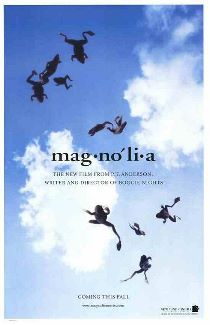 |
1.
Magnolia (Paul
Thomas Anderson,
1999).
Those viewing
Paul Thomas Anderson's deeply metaphoric dissertation
appear to have segregated into two very distinct camps -
those who appreciated the director's infinitely layered
themes and motifs and those who marched out of their
seat, halfway through, shaking their fist for a refund
from the theater manager -> 'Dammitt!', It's hard to deny
Magnolia's
unapologetic intensity which is only accentuated by a
perfect balance resonating the dizzyingly hypnotic
narrative and the intoxicatingly rich actor-driven
performances casually wedged in-between. As modern
poetry it easily towers over anything Hollywood produced
in entire 90's. Anderson, along with Shyamalan, and as
an outside chance Gallo, mark themselves as the potential future of any
healthy-production autuerist-leaning cinema that might
evolve from a studio system (ie be granted a major
release). Audacious
Magnolia with its
brilliant writing, hermetically tight editing and
imbedded personal embraces may be the poster boy for
this hopeful ideal. Regardless, I suspect
Magnolia may
continue to diverge audience taste for the next few
decades. Further to its credit. |

|
2.
In The Bedroom (Todd
Field, 2001).
Considered an
independent release, the cinematography of
In The Bedroom
contains very few panning shots (mostly a static camera)
ingratiating the film with a very personal and
simplistic aura. In a quiet Maine enclave the scenario
evolves with such middle-class normalcy it creeps up on
you with the overly-relaxed atmosphere gaining momentum
towards an intense brooding fury - and it is ours. The pain overcomes us with sparse dialogue
and we can feel the devastation of loss blossom to
uncomfortable proportions.
Like
The Three
Burials of Melquiades Estrada
and
A History of Violence
director Todd Field's masterful feature debut tugs at
our sense of justice and vengeance - but the emotions
are nobly controlled. Imbedded deep in Field's
impressive narrative are overtones of both a political
and psycho-sexual nature. One can only imagine what some
ham-fisted hack would have done to the delicate balance
of gentility and darkness had it been forced to
transverse the usual Hollywood production cycle to
completion. Films are this powerful because
the audience is treated as an adult - not simply a drone
seeking bright lights and fast escapism. |
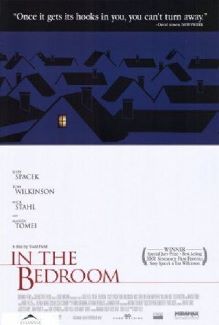 |

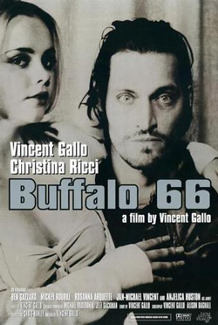 |
3.
Buffalo 66 (Vincent
Gallo, 1998).
A cult gem of 90's indie cinema
Buffalo 66
starred, and was written and directed by, Vincent Gallo. The
only way to bear the high level of anguish in Gallo's
deeply expressionist film is have the script cascade
into dark comedy - which it does with flawless timing.
One uncomfortable visit home is enough to underscore
protagonist Billy Brown's demoralized upbringing and
explain his misdirected bravado-anger. Gallo's
impressive superimposed flashbacks and brilliant
short-take ellipses show us a confident filmmaker who
knows his stuff... and is bold enough to utilize its
subtle power. It is hard to put into words how well the
dialogue meshes with the evolving love story of two
pitifully lonely people, but it's part of the crusty
evolutionary magic of this film experience. Examples of hilarious
caricatures underscore the important drive of the film -
that often the choice between 'giving up' or 'striving forward',
after a horrible string of luck, is simply having one
person who believes in you. Backed by Japanese
financiers, Gallo's
The Brown Bunny certainly deserves a strong
mention - it is another film further defining him as a
unique cinematic force demanding to be heard.
|

|
4.
25th Hour (Spike Lee, 2002).
The
anticipatory seed of Spike Lee's directorial maturity
sprouts to greet us with his best film in the last 15
years. Monty (Edward Norton) is an upscale New York drug
dealer who has been nabbed by authorities and must pay
the price - an impending 7-year prison term. His
echoing lament of "if it only hadn't happened" is easily
reflected as the tragedy of 9/11. Whether it be the blue
searchlight beams from ground zero or the ode to
firefighters in Monty's father's bar, the references are
continuously evident. Is Monty the microcosm of a
shell-shocked America? - confused about who has betrayed
him? - critical of his own complacency? - weary of the
undetermined prospects that the near future has in
store? The open-ended speculative nature of these
critical focal points seems too coincidental. In
addition there are a multitude of non-judgmental
interpersonal issues that face direct comparisons
touching upon the myriad of subtleties of the consistent
coda of directors like Zhang Yimou or Abbas Kiarostami .
These can be digested in different portions by different
viewers - but the contemplative nature is evident.
|
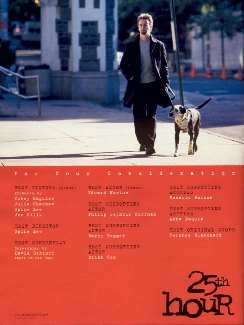 |

 |
5.
House of Sand and Fog (Vadim
Perelman, 2003).
Yes, this Greek-tragedy wannabe could be described as
melodramatic, but character-driven stories often are and
not always as appealing to many who crave continuous
stimulation through action or suspense. This was an
intense study on how fate conspired against 5
individuals. My only real complaint is that the
circumstances in the plot, at times, could seem a tad incongruous. I won't spoil it with specific details, but in
post-analysis of the film you may find
yourself giving up less of your suspension of disbelief.
This is especially true when the film attempts to keep
to the timeline of occurring over less than a 2-week
span. Personally, I was too totally wrapped-up in the
performances - possibly Ben Kinsley's best... ever, and
Jennifer Connelly was not far behind. This effort by
first-timer director Vadim Perelman was, for many, not
perfect - but I am whole-heartedly recommending it as
one of the better films of 2003. Roger Deakin's
cinematography is another huge plus! |

|
6.
The Big Lebowski
(Ethan Coen & Joel Coen , 1998).
Released
in 1998 the Coen brothers recognized masterpiece
The Big Lebowski
centers around the confluence of divergent U.S. cultural
anomalies that are defined by the essential qualities of
two decades. We meet characters that are stuck in the
70's and who are unable or unwilling to adapt to the
absurdist foibles of the 90's. The cultural referencing
continues with a focal backdrop of the unique community
that has fashioned itself around the American pastime of
bowling. The Coens also found time in the films 118
minutes to honor past genre's including westerns,
hard-boiled detective pulp and Busby Berkley musicals.
Almost surrealist with its stylistic directions
The Big Lebowski
playfully stimulates and forces us to succumb to its
vaudevillian charms. A gregarious film that continues to
improve with age and gets better with repeat viewings.
Perhaps its greatest asset is that it fashions itself
promoting the quintessential joy of film... and why it
gives us so much pleasure and satisfaction. |
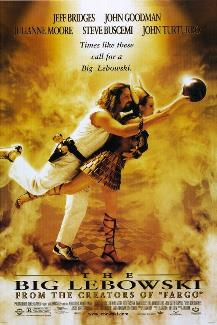 |

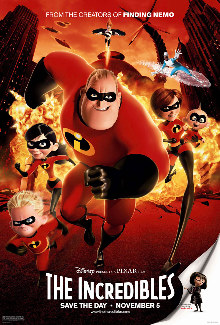 |
7.
The Incredibles
(Brad Bird, 2004).
The
archetypal family has never been so succinctly
represented right down to the 2.5 kids. But the twist is
that these characters are a family of secret-identity
superheroes forced to legally live a quiet suburban
life... but of course, circumstances steer another
course. This film has so many strengths including three of
the best female characters in any film of the past 10
years, but the
soundtrack, with riffs from Matt Helm to James Bond, is
one of the key elements to its perfect atmospheric
enjoyment. Kudos to Pixar for not including (again) the
droning nasal crooning of Randy Newman (nephew to the
great film score icon Alfred Newman). The animation and
voices (Holly Hunter especially) are spot-on and at its
core the film deals with universal family issues
including mid-life crisis, jealousies, selfless
motherhood, precocious pre-teen acceptance, power,
friendship and the importance of that precious nuclear unit. Set for an
obvious and much
desired sequel - THIS is the most
equalized adult-appealing-children's-film ever created. And thank
goodness it is so re-watchable as my son has forced me
to see it over 40 times (I'm not exaggerating!). |

|
8.
The Village
(M. Night Shyamalan, 2002).
There are a couple of things that I really like about
The Village .
Firstly, I love it when great films are immediately
snuffed out by critics - it is often an indication that
there is something subversive that they don't tolerate,
appreciate
or understand. Secondly, I rated M. Night Shyamalan very
highly before this film came out - and it allowed me to
gleefully bump him up to a whole new category of
directorial grasp and expression. "The
Village", also written by Shyamalan, has
incredible depth of construction. Its political
connotations can be read with great obviousness - an
isolated community exists where truisms of the world are
suppressed by their leaders, hidden to the oblivious
inhabitants. The citizens are manipulated by fear,
constantly worried that their boundary could be breached
by an unknown evil. Topical? - I would think so. But then again,
it doesn't have to. It remains to be appreciated for
many other reasons. So many were quite
disappointed that they are not seeing a "Blair Witch"
horror imitation as it was unsuccessfully marketed. Instead we have a revealing story
incubating truths, love, morality, suspense and keen
political nuances. Quite unforgettable. Yes, I'll say
it: a masterpiece. |
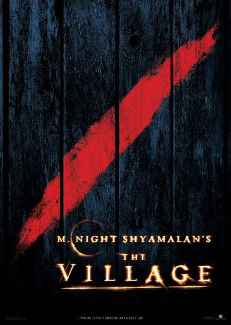 |

 |
9.
Brokeback Mountain
(Ang Lee, 2005).
'Brokeback Mountain' runs to almost isolated perfection for its
first 3/4's running time - it falls back slightly - and
eventually rises in a delicate conclusion to give us Ang
Lee's best offering to date. This is not a good film -
this is a great film. This is not simply a 'gay love
story' but rather a sublime, courageous, touching and
heartfelt story of desire... and yes, the star-crossed
lovers happen to be male, and happen to be cowboys too.
It is their rugged essence that Lee captures so
succinctly - morally conscious, quiet natured men whose
actions speak for them in place of verbal communication.
These attributes seem very easily translated to our
homosexual protagonists - but it's this unique
circumstance that helps promote such keen interest. The
performances are solid, the soundtrack dignifies the
mood and the entire premise exposes a common
bigotry - one that some people live with on a daily
basis. Regardless of that underlying current - it is the
best unrequited love story since Wong Kar Wai's
In The Mood For Love.
|

|
10.
A History of Violence
(David Cronenberg, 2005).
The
questions we are asking in David Cronenberg
A History of Violence
are personal moral probes - do we have the nobility to
opt for a simple pastoral lifestyle -
desirous that
the story steers in that direction?
or do we overly-crave the heroic and vengeful manner of
cinema violence? Innocence vs. corruption. Is it
possible that Mr. Cronenberg can sate us in both arenas?
Do we require the thriller aspects of film to escalate
in rudimentary fashion - with it, infusing the usual
run-in-the-mill seedy and evil gangster caricatures that
we know so well - and love to hate? Can't we simply
brush them aside... yet still somehow feed our
inglorious hunger for the darker side of humanity. Can
we disguise our ever-increasing passion for the human
conflict and retire to a world where an amber light does
not mean 'speed up'? Do we have the strength to be so
guileless? I don't think Mr. C really thinks so - it's a
desensitizing drug that we hunger for... and he's the
pusher. But is he really telling us that by examining
our desires it may be the first step to becoming
cognoscente of where we focus our preferences. I'd like
to think so anyway.
|
 |

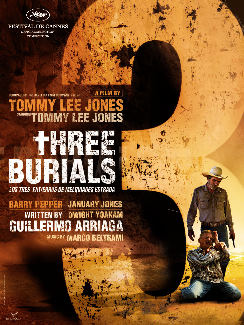 |
11.
The Three
Burials of Melquiades Estrada
(Tommy Lee Jones, 2005).
In the
directorial debut of veteran actor Tommy Lee Jones, we
are presented a tale of deep male friendship - based, it
appears, on the cowboy precept (drawn upon in
Brokeback Mountain)
that actions speak louder than words. Most commonly male
bonded stories are examined in film with seething
conflicts rather than based on loyal selflessness.
Three
Burials... inherently reminds
us that the most noble deeds are the ones in which
there is no expectation of recognized honor.
A level of patience is required to follow the
non-sequential timelines, but it doesn't take long to
figure things out. A Texas
ranch foreman, Pete Perkins (played by Jones) is trying
to bury his Mexican friend, Melquiades Estrada (played
in flashback scenes by Julio Cedillo), back in his homeland.
Simultaneously he intends to make the murderer, a
newly-arrived U.S. border patrolman, Mike Norton (Barry
Pepper), personally accountable. The two men and a corpse start a
journey that quickly transcends to a spiritual one...
ultimately steering towards the allegorical. Jones is a native Texan and part of the shooting
location was the cattle ranch he owns near San Antonio.
His appreciation of the terrain is clearly evident.
With a backdrop of the wide open American West, Jones
plays on a socio-political context of racism,
loneliness, desire, redemption and love. One of the most
poetic and human films of the past decade.
|

|
12.
Me and You and Everyone We Know
(Miranda July, 2005).
Well, I enjoyed this film way out of proportion to what I
was anticipating. Winner of the Camera d'or Award for best
first film at the Cannes Film Festival, Miranda July's
directorial debut focuses on a separated, but calmly
centered, shoe salesman (John Hawkes) and an eccentric
square-peg performance artist (played by director/writer
July). They connect with parallel stories of both children
and the elderly, coping to mature in a modern word, in
this unique and at times devastatingly humorous, expression of
contemporary existence. Touching on facets of love,
longing, self-support, aging, raising children... the
film powers through poignant scene after scene - graced
with a baser human touch. The
trouble is where do you go from here Miranda? |
 |

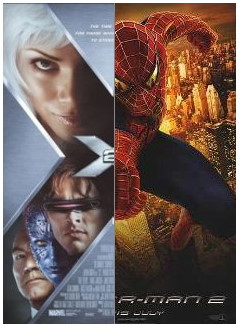 |
13/14.
X-Men 2 /
Spiderman 2 (2003,
2004 respectively).
Struck last
on the list - almost as an after thought - the two best
comic-book incarnations ever put to film came out in the
past three years. They are an obvious pairing. Both are
infinitely more polished sequel adventures than their
initial 'origin' releases. Defining the modern hero in
Stan Lee's Universe would not seem an easy task...
especially with his loyal minions of overly devout
readers peering over his shoulder with magnifying-glass
in tow. But, if either film has a flaw it may be that
they are simply more obvious than the slim bound
narrative wonders that are graphically evolving from the
amazingly imaginative think-tank at Marvel. As with
their colored newsprint counterparts - the focus of each
story is... humanity. Our ability to co-exist and
celebrate our differences. To pull together and unite.
I'm a sucker for that level of Roddenberry-esque
optimism. There is also the wonderfully vast array of
eclectic characters that inhabit these films - and yet
they all share the same desire - they strive for
'normalcy'. But the acceptance of uniqueness gives them
their most human appeal. Sure, it's teenagers that are
the biggest recipients of this particular growing pain
maturity... but for the ensuing generations the plots
boil over like modern Shakespeare. Perhaps I'm an easy
sell - or still a pre-teen at heart, but my advice is
don't deprive yourself. These films are rare gems with
enough flashing light and CGI action to mass market as
well. |
|













